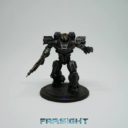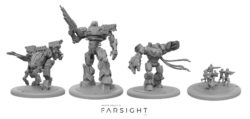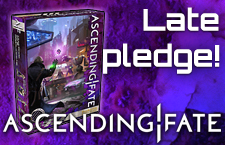Farsight: Mech-Spiel bald auf Kickstarter
Von Braincrack Games soll schon bald ein neues Spiel kommen.
„Standing as high as a 10-storey building, Prototypes were the worst nightmares of infantry – wrought from steel and fire and made real. When the corporations began their land grabs, Prototypes were an invaluable tool. They took years to build, but when they were completed, they could seize entire cities in a day, forcing the enemy to run scared – or even better, draw their fire whilst assault mechs brought in the flanks.“
In Farsight, the deadly prototypes tower over the other miniatures on the board. Which of the five designs is your favourite? Which one should we include? Let us know in the comments!
What do you think of our latest miniature?
Standing tall above infantrymen, the „Armour“ mech was designed to take as much of a beating as possible, keeping the enemy busy whilst more mobile units moved into position.
However, Armour units are still a formidable foe: they’re piloted by remote engineers, removing the need for a pilot and giving more space for solid steel armour. With extended multi-tool ‚tentacles,‘ they can quickly survey their blind-spots and small buildings to give them an advantage in close combat, and unleash their mounted machine guns and missiles.
(bemalter 3D-Druck)
One of the things we loved about Farsight when we first played was the surprises it offered: if your spy network isn’t built up, it can often be a nasty surprise what’s waiting for you on the other side of the battlefield.
When face-down unit pieces enter combat, they are revealed – and sometimes, your puny infantry unit is up against a much bigger threat than you anticipated. It’s good fun.
With the miniatures, we wanted to amp up this drama even more – with accurately-scaled unit minis, this big reveal will be just as exciting – or terrifying – as we always wanted it to be.
Developed over 8 years by veteran wargamer Jamie Jolly, Farsight offers a rich and fresh take on the world of war-gaming: combining fog of war mechanics, hidden units, dynamic and interactive terrain, and unpredictable events, into a simple and fluid system that will appeal to newer gamers and hardened tacticians alike.
Players control one of the four dominant corporations, in a campaign to control a sprawling map of forests, mountains, lakes, and tactical objectives. Everything from positioning to weather to terrain is crucial to succeeding in combat, ensuring a tactical implication of every move.
In the design of Farsight, a key goal has been giving players the freedom to be creative: unlike games with pre-written strategy cards or restrictive paths to victory, Farsight gives you the power to play how you want. Whether it’s tailoring the rules to your desired play experience or skill level, creating custom armies to enhance your planned strategy, or adapting tactics from history for use in-game, Farsight puts players firmly in control from start to finish.
During the game, players deploy and control two distinct types of unit: Battlefield Units – such as infantry, armoured mechs, artillery and towering ‘Prototypes’ – and Specialists – such as Spies, Saboteurs, Seers and Assassins.
Battlefield Units are deployed directly to the map: engaging with the enemy, using the terrain to their advantage, taking casualties, and reacting to battlefield events such as blizzards or fog. They’re the bread and butter of any army: capturing the objectives needed to win the game, and defending your territory from the enemy.
Specialists, whilst much more subtle, are just as crucial to victory. Deployed to the shadowmap (a hidden board that relates to the map itself,) Specialists do not move, but offer unique abilities, such as predicting events, sabotaging enemy units, spying on your opponent, or hunting enemy specialists.
Information is a big step towards effective strategy: battlefield units are deployed face-down, appearing as mere blips on the radar until they are engaged or spied upon. Deploying spies to reveal enemy units early on allows you to plan ahead, intercepting powerful units and maneuvering to destroy their supports ahead of time.
Once you’ve held 8 bases for a whole turn – or the 3 closest bases to the enemy for one turn – your corporation claims their dominance, and has won the battle… for now.
Im Blog der Macher gibt es ausführlichere Artikel:
Der Kickstarter soll im April kommen.
Quelle: Braincrack Games bei Facebook
















Ich frage mich immer wieder, warum so ein riesiger Mech mitunter seine Wafe wie ein Gewehr mit sich herumträgt. Damit sieht der größere Walker irgendwie leichter bewaffnet aus als der kleinere, waffenstarrende.
Gute Grundidee, aber irgendwie sprechen mich diese Mechs leider nicht an…
Jupp… sehe ich auch so… viel zu Störanfällig im Feldeinsatz.
Zumal auch keine anderen Vorteile.
Mein absoluter Lieblingsmech war der „Marodeur“ – also der alte… ein geniales Design…
Was ist der Vorteil eines Mechs gegenüber einem Panzer (mal vorausgesetzt man könnte einen bauen, der sinnvoll funktioniert) ? Er kann Gelände überwinden, das selbst den Panzer aufhält. Steilwände zum Beispiel. Ausserdem ist er in der Lage, seine Gliedmaßen für Nahkampfangriffe einzusetzen.
Ziemlich nützlich, wenn man dazu 2 freie Greifwerkzeuge (vulgo Hände) hat. Ein „Gewehr“, das der Mech im Fall der Fälle loslassen kann, ist eine Möglichkeit, das umzusetzen.
Außerdem: Waffen im Gewehrdesign lassen sich sehr einfach austauschen und dem Bedarf anpassen.
Aber der Marodeur ist in der Tat ein super Design, wobei mein Liebling der Supernova-Mech ist. (Weil mein erster Kontakt mit Mechs Mechwarrior 3 war 🙂 )
Cool von allem etwas Armored Core 1:1 umgesetzt und anleien von Metal Gear Solid, sehr schön.
@Ferox noch nie ein Anime gesehen ??? so kann er die Waffe schneller weglegen , sachen greifen und ist dadurch beweglicher und wendiger .Als wenn alles auf im drauf gebaut wäre.
Kann man durch integrierte Waffen auch erreichen, es gibt genügen Mechs mit Waffen und Händen die nicht extra eine Waffe rumschleppen.
Klar, über/unter/neben der Hand montieren funktioniert auch, damit opfert man aber die simplere Wartungs-/Austauschmöglichkeit (Waffe A hinlegen, Waffe B aufheben, vielleicht noch Munitions-/Energiezufuhr lösen/anschließen, fertig). Das könnte im Feld tatsächlich einen Unterschied machen.
Theoretisch könnte man eine Waffe, deren Munitionsvorrat erschöpft ist, so auch ablegen, um das Gesamtgewicht der Maschine zu verringern, was sich positiv auf wahlweise Geschwindigkeit/Beweglichkeit oder Energieverbrauch auswirken könnte.
Ob einem das optisch gefällt ist Geschmackssache, aber offensichtlicher Unsinn ist es (innerhalb der Annahme „Mechs ergeben Sinn“) nicht.
Ich werde bei Mechs grundsätzlich immer erstmal hellhörig, und das allgemeine Design gefällt mir hier durchaus. 🙂 Da bleibe ich definitiv dran.
@ Fero21 und Beloq: Es sind Genre-Tropen.
http://tvtropes.org/pmwiki/pmwiki.php/Main/Mecha
„The classic Eastern-style mecha is the Humongous Mecha; essentially giant infantry, they’re usually humanoid, wield hand-held weapons like a human soldier, and are relatively light on their feet. The typical Western-style mecha, on the other hand, is a Walking Tank; nonhumanoid, with fixed or turreted weapons, and favoring heavy armor over nimbleness.“
Zum Spiel selbst…zuwenig Infos. Das Konzept eines Mecha-Spiels, welches eher in Richtung Brettspiel statt Tabletop geht ist ansprechend, aber ich sehe bis dato noch keinen Grund zur Euphorie. Ich hoffe, da kommen schnell mal ein paar konkrete Fakten anstatt dem bisherigen Marketing-Geschwurbel.
Das Battle in a Box Konzept interessiert mich am meisten. Die Mech Designs find ich auch nicht so gut.
Huch vergessen mehr zu schreiben.
Das Gameplay klingt aber interessant. Errinert mich ein bisschen an Hind Commander. Von den Grundideen zumindetens.
Ist das in irgendeinem gelaeufigen Massstab oder einfach nur „passend gemacht“?
Ich bin der Verleger!
Danke für deine Frage. Alles außer der Infanterie sind in relativer Skala: In Wirklichkeit wären sie kleiner, aber wir wollten mehr Details über die Miniaturen.
Sorry für meine arme deutsche!
-Lewis
Thanks for posting here. Can you give us the size of the mechas and soldiers? Are they compatible with common tabletop scales?
All the bases are 44mm, with 20mm, 30mm and 55mm heights for the Infantry, Assault/Armour and Prototypes respectively.
-Lewis